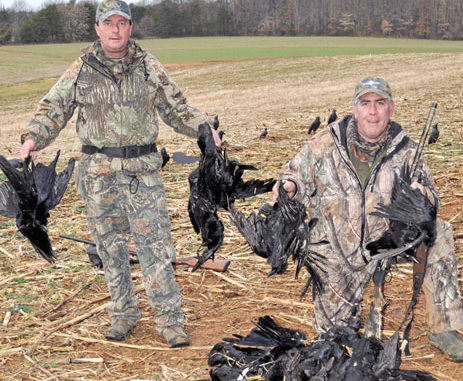
Reidsville’s Sandy Brady loves hunting crows, and farmers are glad to have him shoot these crop destroyers.
It was a typical, pre-dawn February morning in North Carolina’s Piedmont — completely dark and extremely cold. Rolling along, hoarfrost painted feathery patterns on the windshield of Sandy Brady’s SUV, and minutes later, the ground crunched under his feat as he walked the edge of a cornfield, loaded down with bags of decoys and shotguns.
“We gotta get these decoys out and in the right place before it gets light,” said Brady, 42.
A couple of hours earlier, at 5 a.m., Brady and one of his boyhood friends, Randy Shreve, had met at a cozy little restaurant in Reidsville for a country-style breakfast of scrambled eggs and bacon, washing it down with steaming coffee. It was a morning that required fuel to warm the inner man, especially with a date in sub-freezing weather approaching.
From the equipment in the back of Brady’s truck — decoy bags, decoys, shotguns, boxes of shells, gloves, boots and camouflage clothing — it appeared he was getting ready for a day of waterfowling.
But after breakfast, he drove a few miles to a cornfield instead of a lake, river or beaver-pond marsh — they would not see a duck all day.
“Crow hunting is what I like to do, and I do it every day I can,” said Brady, who operates a rock-etching business called “Pet Rocks.”
The N.C. Wildlife Resources Commission allows crow hunting on Wednesdays, Fridays and Saturdays, plus holidays, from Aug. 1 to the end of February and from June 1 to July 31.
“I call crow hunting ‘redneck duck hunting,’” Brady said, grinning.
Living in the piedmont, where big water and ducks are rare, Brady long ago lost his interest in waterfowling. He also doesn’t favor long trips to the coast when he’s got plenty of live targets that local farmers are more than happy to provide.
“Wait until you have to buy eight bushels of corn to replant your fields because of damage by crows,” said Wallace Johnson, a local farmer who also owns Johnson Sporting Goods in Ruffin. “That’s why I like to give permission to Sandy to come shoot crows on my land.”
Brady’s father, legendary outdoorsman Pat Foy Brady, started his son crow hunting “as far back as I can remember,” he said.
“I can recall when I was six or seven years old, when Dad wouldn’t take me with him, I’d get mad,” Sandy Brady said. “I’d actually run away from home if he left me at the house.
“Then he started taking me, but he’d make me sit beside him and go pick up the crows he’d shot. When I was eight, he gave me a shotgun and one shell. That was my training to become a good shot; I had one shell. It was a good way to teach a youngster gun safety and how to become a good shot.”
By the end of that year, Brady said he was regularly killing a 12-bird limit each time his dad took him dove hunting.
Since then, he’s become a great wingshot, and many farmers in Rockingham County know Brady, because at one time or another, he’s stopped by their houses, asking permission to hunt crows.
Although it may seem unnecessary to kill crows, several reasons exist that aren’t immediately apparent. Crows cause untold crop and wildlife damage each year. They’ll devastate young row crops, especially corn, and may peck holes in watermelons and cantaloupes. Where their ranges overlap, crows also can be devastating to waterfowl populations. When ducks begin laying in the spring, crows will eat eggs, and they have been know to return and eat fledgling ducks.
During the 1940s, a survey in Canada showed that each crow killed on average 110 to 120 fledglings during nesting season — approximately 20 million ducks per year. The same year of the survey, hunters only killed 11 million ducks.
Crows also can affect upland gamebird populations, and they will prey on small game such as rabbits and squirrels. They’ve even killed newborn lambs.
Perhaps the best reason to kill crows is to prevent the spread of West Nile virus, an encephalitic-type disease that has killed at least 155 people. Crows are premier carriers of the mosquito-born illness because of their sensitive nature to the virus, roosting habits and tendency to migrate.
But Brady mainly hunts them for fun and because local farmers beg him to come rid their fields of the pests.
“It’s a real test of your shooting ability to hunt crows,” he said, “but you’ve got to be able to call them in.”
Brady said January and February are the best months to hunt crows in central North Carolina.
“The birds are migrating through here then,” he said. “They start at the end of December and go to the end of February. They’re going north. New York and those areas have lots of crows (in the spring and summer).”
When he’s riding around Rockingham County, Brady remains on the lookout for crows. He’ll stop and glass harvested cornfields for birds, either flying or on the ground.
“I’m always looking for large concentrations of crows,” he said. “If I’m ‘spot’ hunting and see 25 or 30, I may stop and ask the landowner permission to hunt them.”
Most of the time, farmers oblige him, especially if they’re corn growers.
Successful crow hunting has six key elements:
• Getting out to a field before the crows start flying;
• Setting out decoys;
• Camouflage;
• Calling;
• Correct shotgun loads;
• Wingshooting ability.
“I like to put out at least 70 decoys before it gets light enough to see, but sometimes I’ve used as few as 20,” Brady said. “But the rule of thumb generally is: the more decoys, the better.”
However, those decoys aren’t all plastic copies of crows.
“I’ll put some (plastic) birds in the trees at the edge of a field because you want the crows flying in to be able to see there are crows in the trees,” Brady said, because flocks of crows generally designate two or three scouts, who’ll fly to trees around a field’s perimeter and watch for danger while the main flock lands on the ground to eat.
“I’ll also use dead crows (as decoys on the ground),” Brady said. “Even though crows have tremendous eyesight, they don’t seem to know the difference between a live or dead crow on the ground.”
His truck is often loaded with a sack of dead birds he scatters on the ground near the edge of a field, covering perhaps a 50-foot square area. He also place a few plastic decoys in the mix.
Camouflage clothing is a necessity because of the keen eyesight of most crows. That includes some type of facemask and gloves.
“They can see your face shining if you don’t have on a facemask,” Brady said, “and they’ll shy off instead of coming in close enough for a shot. It’s also important to set up with the sun to your back in the morning. That way you don’t have the sun in your face when crows are flying across a field to you.”
The ideal shooting distance for crows is 25 to 30 yards.
“You want to get hidden in the woods next to a field with your decoys,” Brady said. “You don’t have to be right next to the field either. In fact, it’s probably better to be 10 to 20 feet inside the woods line because you’re going to get crows coming in from all directions. They’re going to come flying across the open field, but a lot of crows will come from the woods to the field, and some fly the sides of fields.”
Brady said a hedgerow running through the middle of a field that’s next to a riverbottom is one of his favorite ambush spots.
“Crows really seem to like riverbottom fields,” said Braddy, who uses an electronic Fox Pro caller with an audio disk that mimics the raucous calling of a flock of crows.
“It makes what I call a ‘gathering’ call,” Brady said, “but I also use a mouth call in addition to the electronic call. I make a ‘come here’ call with the mouth call.”
He uses the mouth call because of its greater volume. Crows can hear his mouth call from a greater distance than the electronic call.
“I started using the Fox Pro call two years ago,” he said. “Before then, I just used mouth calls. I still use the mouth call, because you can call crows in from longer distances. I’ve had crows come (to the mouth call) from a mile away. The maximum range of the Fox Pro is about one-half mile.”
When a group of crows is coming to his calls, Brady said the key to getting more than one shot is to shoot the first bird that reaches shotgun range.
“If the lead crow falls, he doesn’t have a chance to give a danger call, which is like a turkey’s putt,” he said. “If the other crows see him falling, they think he’s going (to the ground) to feed. But if you miss him, they’re gone.”
Brady owns a variety of scatterguns, but for crow hunting prefers a Beretta 12-gauge autoloader that shoots high-brass 2¾-inch shotshells in No. 6 or 7 sizes with a modified or full choke.

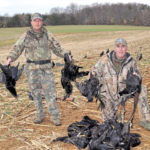
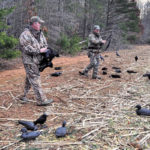
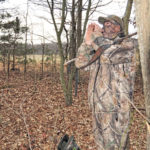
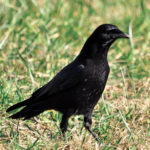
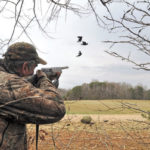
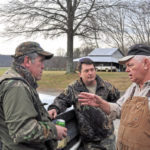



Be the first to comment